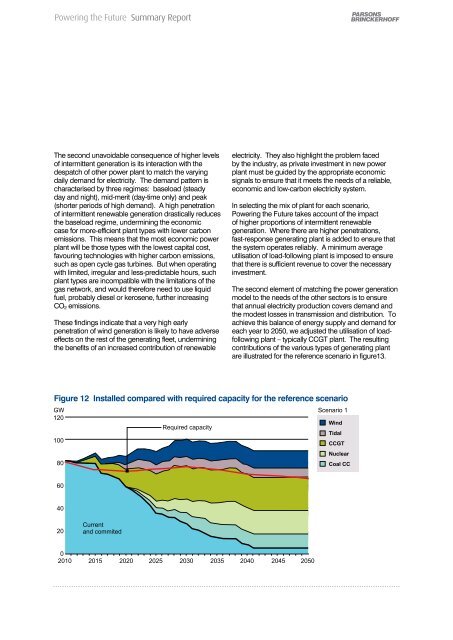Powering the Future Summary Report - Parsons Brinckerhoff
Powering the Future Summary Report - Parsons Brinckerhoff
Powering the Future Summary Report - Parsons Brinckerhoff
Create successful ePaper yourself
Turn your PDF publications into a flip-book with our unique Google optimized e-Paper software.
<strong>Powering</strong> <strong>the</strong> <strong>Future</strong> <strong>Summary</strong> <strong>Report</strong><br />
<strong>Powering</strong> <strong>the</strong> <strong>Future</strong> <strong>Summary</strong> <strong>Report</strong><br />
The second unavoidable consequence of higher levels<br />
of intermittent generation is its interaction with <strong>the</strong><br />
despatch of o<strong>the</strong>r power plant to match <strong>the</strong> varying<br />
daily demand for electricity. The demand pattern is<br />
characterised by three regimes: baseload (steady<br />
day and night), mid-merit (day-time only) and peak<br />
(shorter periods of high demand). A high penetration<br />
of intermittent renewable generation drastically reduces<br />
<strong>the</strong> baseload regime, undermining <strong>the</strong> economic<br />
case for more-efficient plant types with lower carbon<br />
emissions. This means that <strong>the</strong> most economic power<br />
plant will be those types with <strong>the</strong> lowest capital cost,<br />
favouring technologies with higher carbon emissions,<br />
such as open cycle gas turbines. But when operating<br />
with limited, irregular and less-predictable hours, such<br />
plant types are incompatible with <strong>the</strong> limitations of <strong>the</strong><br />
gas network, and would <strong>the</strong>refore need to use liquid<br />
fuel, probably diesel or kerosene, fur<strong>the</strong>r increasing<br />
CO 2 emissions.<br />
These findings indicate that a very high early<br />
penetration of wind generation is likely to have adverse<br />
effects on <strong>the</strong> rest of <strong>the</strong> generating fleet, undermining<br />
<strong>the</strong> benefits of an increased contribution of renewable<br />
electricity. They also highlight <strong>the</strong> problem faced<br />
by <strong>the</strong> industry, as private investment in new power<br />
plant must be guided by <strong>the</strong> appropriate economic<br />
signals to ensure that it meets <strong>the</strong> needs of a reliable,<br />
economic and low-carbon electricity system.<br />
In selecting <strong>the</strong> mix of plant for each scenario,<br />
<strong>Powering</strong> <strong>the</strong> <strong>Future</strong> takes account of <strong>the</strong> impact<br />
of higher proportions of intermittent renewable<br />
generation. Where <strong>the</strong>re are higher penetrations,<br />
fast-response generating plant is added to ensure that<br />
<strong>the</strong> system operates reliably. A minimum average<br />
utilisation of load-following plant is imposed to ensure<br />
that <strong>the</strong>re is sufficient revenue to cover <strong>the</strong> necessary<br />
investment.<br />
The second element of matching <strong>the</strong> power generation<br />
model to <strong>the</strong> needs of <strong>the</strong> o<strong>the</strong>r sectors is to ensure<br />
that annual electricity production covers demand and<br />
<strong>the</strong> modest losses in transmission and distribution. To<br />
achieve this balance of energy supply and demand for<br />
each year to 2050, we adjusted <strong>the</strong> utilisation of loadfollowing<br />
plant – typically CCGT plant. The resulting<br />
contributions of <strong>the</strong> various types of generating plant<br />
are illustrated for <strong>the</strong> reference scenario in figure13.<br />
Connecting new generating stations to <strong>the</strong> grid<br />
network and to consumers is a key element of adding<br />
new capacity to <strong>the</strong> UK electrical system. Most of<br />
<strong>the</strong> existing transmission networks were constructed<br />
more than 40 years ago and have been progressively<br />
uprated and reinforced since that time. Spare capacity<br />
is limited, and connections for new generating capacity<br />
in many areas of <strong>the</strong> country cannot be provided<br />
in less than five years as new transmission lines<br />
and substations must first be designed, permitted,<br />
purchased and installed. This issue is accentuated<br />
by <strong>the</strong> growth of coastal and offshore intermittent<br />
renewable generating capacity which is often remote<br />
from <strong>the</strong> main transmission network.<br />
Although <strong>the</strong> transmission and distribution networks<br />
face serious issues, <strong>the</strong>y can be resolved by<br />
appropriate investment. For <strong>the</strong> purpose of this<br />
study it has been assumed that <strong>the</strong> timing and<br />
scale of development of <strong>the</strong> electrical networks will<br />
not constrain <strong>the</strong> benefits from <strong>the</strong> CO 2 reduction<br />
measures.<br />
Figure 12 Installed compared with required capacity for <strong>the</strong> reference scenario<br />
Figure 13 Electricity production by generation technology<br />
33:34

















